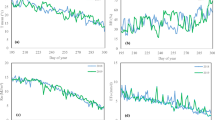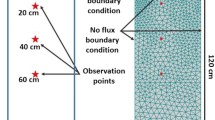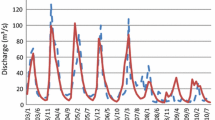Abstract
Proper management of fertigation is necessary to deal with the harmful impacts of fertilizers. This research aimed to investigate the nitrate leaching rate into groundwater in different fertigation management under the climate change impact in drip irrigation of corn. For this purpose, HYDRUS-2D was calibrated by performing field experiments. Plant water requirement and rainfall were projected until 2050 using LARS-WG6 under the RCP85 scenario. Then, nitrate leaching up to groundwater at the depth of 5 m was simulated in the growing season of corn and the like until 2050 in three fertigation scenarios, including S1 (three regional fertigation splits with irrigation efficiency of 85%), S2 (weekly fertigation with irrigation efficiency of 85%), and S3 (optimum fertigation with irrigation efficiency of 100%). Finally, the annual nitrate leaching rate to groundwater and leached amount were compared in the studied scenarios. The results demonstrated that nitrate penetrated to the depth of 117 and 105 cm at the end of the first year in S1 and S2 scenarios, respectively. In these scenarios, nitrate will reach groundwater in 2031, but nitrate concentrations will not be the same. In the S3 scenario, the nitrate will reach a depth of 180 cm by 2050. Total leached nitrate to groundwater up to 2050 will be 1740, 1200, and zero kg/ha in S1, S2, and S3 scenarios, respectively. Based on the approach of this study, the vulnerability of groundwater to nitrate contamination in different agricultural areas can be evaluated, and appropriate strategies with minimum environmental impacts of fertilizer abuse can be selected accordingly.








Similar content being viewed by others
Data availability
The datasets generated during and/or analyzed during the current study are available on reasonable request.
Code availability
Generated codes during the current study are available on reasonable request.
References
Abascal, E., Gómez-Coma, L., Ortiz, I., & Ortiz, A. (2022). Global diagnosis of nitrate pollution in groundwater and review of removal technologies. Science of the Total Environment, 810, 152233. https://doi.org/10.1016/j.scitotenv.2021.152233
Abendroth, L. J., Elmore, R. W., Boyer, M. J., & Marlay, S. K. (2011). Corn growth and development. PMR 1009. Iowa State Univ. Extension and Outreach.
Ajdary, K., Singh, D. K., Singh, A. K., & Khanna, M. (2007). Modelling of nitrogen leaching from experimental onion field under drip fertigation. Agricultural Water Management, 89(1–2), 15–28. https://doi.org/10.1016/j.agwat.2006.12.014
Akbariyeh, S., Bartelt-Hunt, S., Snow, D., Li, X., Tang, Z., & Li, Y. (2018). Three-dimensional modeling of nitrate-N transport in vadose zone: Roles of soil heterogeneity and groundwater flux. Journal of Contaminant Hydrology, 211, 15–25. https://doi.org/10.1016/j.jconhyd.2018.02.005
Akbariyeh, S., Pena, C. A. G., Wang, T., Mohebbi, A., Bartelt-Hunt, S., Zhang, J., & Li, Y. (2019). Prediction of nitrate accumulation and leaching beneath groundwater irrigated corn fields in the Upper Platte basin under a future climate scenario. Science of the Total Environment, 685, 514–526. https://doi.org/10.1016/j.scitotenv.2019.05.417
Allen, R. G., Pereira, L. S., Raes, D., & Smith, M. (1998). Crop evapotranspiration: Guidelines for computing crop water requirements. FAO Irrigation and drainage paper 56. Fao.
Arauzo, M. (2017). Vulnerability of groundwater resources to nitrate pollution: A simple and effective procedure for delimiting Nitrate Vulnerable Zones. Science of the Total Environment, 575, 799–812. https://doi.org/10.1016/j.scitotenv.2016.09.139
Arauzo, M., García, G., & Valladolid, M. (2019). Assessment of the risks of N–loss to groundwater from data on N–balance surplus in Spanish crops: An empirical basis to identify Nitrate Vulnerable Zones. Science of the Total Environment, 696, 1–16. https://doi.org/10.1016/j.scitotenv.2019.133713
Azad, N., Behmanesh, J., Rezaverdinejad, V., Abbasi, F., & Navabian, M. (2018a). Developing an optimization model in drip fertigation management to consider environmental issues and supply plant requirements. Agricultural Water Management, 208, 344–356. https://doi.org/10.1016/j.agwat.2018.06.030
Azad, N., Behmanesh, J., Rezaverdinejad, V., & Tayfeh Rezaie, H. (2018b). Climate change impacts modeling on winter wheat yield under full and deficit irrigation in Myandoab-Iran. Archives of Agronomy and Soil Science, 64(5), 731–746. https://doi.org/10.1080/03650340.2017.1373187
Azad, N., Behmanesh, J., Rezaverdinejad, V., Abbasi, F., & Navabian, M. (2019). Evaluation of fertigation management impacts of surface drip irrigation on reducing nitrate leaching using numerical modeling. Environmental Science and Pollution Research, 26, 36499–36514. https://doi.org/10.1007/s11356-019-06699-2
Azad, N., Behmanesh, J., Rezaverdinejad, V., Abbasi, F., & Navabian, M. (2020). An analysis of optimal fertigation implications in different soils on reducing environmental impacts of agricultural nitrate leaching. Scientific Reports, 10(1), 1–15. https://doi.org/10.1038/s41598-020-64856-x
Baghanam, A. H., Eslahi, M., Sheikhbabaei, A., & Seifi, A. J. (2020). Assessing the impact of climate change over the northwest of Iran: An overview of statistical downscaling methods. Theoretical and Applied Climatology, 141, 1135–1150. https://doi.org/10.1007/s00704-020-03271-8
Bremner, J. M., & Edwards, A. P. (1965). Determination and isotope-ratio analysis of different forms of nitrogen in soils: I. Apparatus and procedure for distillation and determination of ammonium. Soil Science Society of America Journal, 29(5), 504–507. https://doi.org/10.2136/sssaj1965.03615995002900050011x
Bremner, J. M., & Keeney, D. R. (1965). Steam distillation methods for determination of ammonium, nitrate and nitrite. Analytica Chimica Acta, 32, 485–495. https://doi.org/10.1016/S0003-2670(00)88973-4
Bremner, J. M., & Keeney, D. R. (1966). Determination and isotope-ratio analysis of different forms of nitrogen in soils: 3. Exchangeable ammonium, nitrate, and nitrite by extraction-distillation methods. Soil Science Society of America Journal, 30(5), 577–582. https://doi.org/10.2136/sssaj1966.03615995003000050015x
Cote, C. M., Bristow, K. L., Charlesworth, P. B., Cook, F. J., & Thorburn, P. J. (2003). Analysis of soil wetting and solute transport in subsurface trickle irrigation. Irrigation Science, 22(3–4), 143–156. https://doi.org/10.1007/s00271-003-0080-8
Dibike, Y. B., & Coulibaly, P. (2005). Hydrologic impact of climate change in the Saguenay watershed: Comparison of downscaling methods and hydrologic models. Journal of Hydrology, 307(1–4), 145–163. https://doi.org/10.1016/j.jhydrol.2004.10.012
Eberhart, R., & Kennedy, J. (1995). A new optimizer using particle swarm theory. In Proceedings of the sixth international symposium on micro machine and human science. Nagoya Japón. IEEE Service Center. https://doi.org/10.1109/MHS.1995.494215
EEA. (2012). European Environmental Agency. Percentage of groundwater body area not achieving good chemical status due to nitrate (a) and total nitrogen input from organic and inorganic fertilizers (b). https://www.eea.europa.eu/data-and-maps/figures/percentage-of-groundwater-body-area/percentage-of-groundwater-body-area
Eltarabily, M. G., Negm, A. M., Yoshimura, C., & Saavedra, O. C. (2017). Modeling the impact of nitrate fertilizers on groundwater quality in the southern part of the Nile Delta, Egypt. Water Science and Technology: Water Supply, 17(2), 561–570. https://doi.org/10.2166/ws.2016.162
Farneselli, M., Benincasa, P., Tosti, G., Simonne, E., Guiducci, M., & Tei, F. (2015). High fertigation frequency improves nitrogen uptake and crop performance in processing tomato grown with high nitrogen and water supply. Agricultural Water Management, 154, 52–58. https://doi.org/10.1016/j.agwat.2015.03.002
Gärdenäs, A. I., Hopmans, J. W., Hanson, B. R., & Šimůnek, J. (2005). Two-dimensional modeling of nitrate leaching for various fertigation scenarios under micro-irrigation. Agricultural Water Management, 74(3), 219–242. https://doi.org/10.1016/j.agwat.2004.11.011
Gelhar, L. W., Welty, C., & Rehfeldt, K. R. (1992). A critical review of data on field-scale dispersion in aquifers. Water Resources Research, 28(7), 1955–1974. https://doi.org/10.1029/92WR00607
Gheysari, M., Mirlatifi, S. M., Homaee, M., Asadi, M. E., & Hoogenboom, G. (2009). Nitrate leaching in a silage maize field under different irrigation and nitrogen fertilizer rates. Agricultural Water Management, 96(6), 946–954. https://doi.org/10.1016/j.agwat.2009.01.005
Hakami-Kermani, A., Babazadeh, H., Porhemmat, J., & Sarai-Tabrizi, M. (2020). An uncertainty assessment of reservoir system performance indices under the climate change effect. Ain Shams Engineering Journal, 11(4), 889–904. https://doi.org/10.1016/j.asej.2020.03.015
Hanson, B. R., Šimůnek, J., & Hopmans, J. W. (2006). Evaluation of urea–ammonium–nitrate fertigation with drip irrigation using numerical modeling. Agricultural Water Management, 86(1–2), 102–113. https://doi.org/10.1016/j.agwat.2006.06.013
Hargreaves, G. H., & Samani, Z. A. (1985). Reference crop evapotranspiration from temperature. Applied Engineering in Agriculture, 1(2), 96–99. https://doi.org/10.13031/2013.26773
Hartmann, A., Šimůnek, J., Aidoo, M. K., Seidel, S. J., & Lazarovitch, N. (2018). Implementation and application of a root growth module in HYDRUS. Vadose Zone Journal, 17(1), 1–16. https://doi.org/10.2136/vzj2017.02.0040
Heydari Tasheh Kabood, S., Hosseini, S. A., & Heydari Tasheh Kabood, A. (2020). Investigating the effects of climate change on stream flows of Urmia Lake basin in Iran. Modeling Earth Systems and Environment, 6, 329–339. https://doi.org/10.1007/s40808-019-00681-0
Hou, Z., Chen, W., Li, X., Xiu, L., & Wu, L. (2009). Effects of salinity and fertigation practice on cotton yield and 15N recovery. Agricultural Water Management, 96(10), 1483–1489. https://doi.org/10.1016/j.agwat.2009.04.019
Huan, H., Wang, J., Zhai, Y., Xi, B., Li, J., & Li, M. (2016). Quantitative evaluation of specific vulnerability to nitrate for groundwater resource protection based on process-based simulation model. Science of the Total Environment, 550, 768–784. https://doi.org/10.1016/j.scitotenv.2016.01.144
IPCC. (2014). Synthesis report. Contribution of working groups I. II and III to the fifth assessment report of the intergovernmental panel on climate change, 151(10.1017).
Kandelous, M. M., & Šimůnek, J. (2010). Numerical simulations of water movement in a subsurface drip irrigation system under field and laboratory conditions using HYDRUS-2D. Agricultural Water Management, 97(7), 1070–1076. https://doi.org/10.1016/j.agwat.2010.02.012
Karandish, F., & Šimůnek, J. (2017). Two-dimensional modeling of nitrogen and water dynamics for various N-managed water-saving irrigation strategies using HYDRUS. Agricultural Water Management, 193, 174–190. https://doi.org/10.1016/j.agwat.2017.07.023
Kazemi, E., Karyab, H., & Emamjome, M. M. (2017). Optimization of interpolation method for nitrate pollution in groundwater and assessing vulnerability with IPNOA and IPNOC method in Qazvin plain. Journal of Environmental Health Science and Engineering, 15, 1–10. https://doi.org/10.1186/s40201-017-0287-x
Kennedy, J., & Eberhart, R. (1995). Particle swarm optimization. In Proceedings of IEEE international conference on neural networks. IEEE Press.https://doi.org/10.1109/ICNN.1995.488968
Kumar, M., Rajput, T. B. S., Kumar, R., & Patel, N. (2016). Water and nitrate dynamics in baby corn (Zea mays L.) under different fertigation frequencies and operating pressures in semi-arid region of India. Agricultural Water Management, 163, 263–274. https://doi.org/10.1016/j.agwat.2015.10.002
Liu, X., Sun, S., Ji, P., & Šimůnek, J. (2013). Evaluation of historical nitrate sources in groundwater and impact of current irrigation practices on groundwater quality. Hydrological Sciences Journal, 58(1), 198–212. https://doi.org/10.1080/02626667.2012.745937
Marinov, I., & Marinov, A. M. (2014). A coupled mathematical model to predict the influence of nitrogen fertilization on crop, soil and groundwater quality. Water Resources Management, 28, 5231–5246. https://doi.org/10.1007/s11269-014-0664-5
Mavromatis, T., & Hansen, J. W. (2001). Interannual variability characteristics and simulated crop response of four stochastic weather generators. Agricultural and Forest Meteorology, 109(4), 283–296. https://doi.org/10.1016/S0168-1923(01)00272-6
Mehan, S., Guo, T., Gitau, M. W., & Flanagan, D. C. (2017). Comparative study of different stochastic weather generators for long-term climate data simulation. Climate, 5(2), 26. https://doi.org/10.3390/cli5020026
Okeeffe, K. (2009). Maize growth & development. NSW Department of Primary Industries.
Osman, Y., Al-Ansari, N., & Abdellatif, M. (2019). Climate change model as a decision support tool for water resources management in northern Iraq: A case study of Greater Zab River. Journal of Water and Climate Change, 10(1), 197–209. https://doi.org/10.2166/wcc.2017.083
Ostad-Ali-Askari, K. (2022). Developing an optimal design model of furrow irrigation based on the minimum cost and maximum irrigation efficiency. Applied Water Science, 12(7), 144. https://doi.org/10.1007/s13201-022-01646-y
Ostad-Ali-Askari, K., Shayannejad, M., & Ghorbanizadeh-Kharazi, H. (2017a). Artificial neural network for modeling nitrate pollution of groundwater in marginal area of Zayandeh-rood River, Isfahan, Iran. KSCE Journal of Civil Engineering, 21, 134–140. https://doi.org/10.1007/s12205-016-0572-8
Ostad-Ali-Askari, K., Shayannejad, M., Eslamian, S., Zamani, F., Shojaei, N., Navabpour, B., Majidifar, Z., Sadri, A., Ghasemi-Siani, Z., Nourozi, H., Vafaei, O., & Amir Homayouni, S. M. (2017b). Deficit irrigation: Optimization models. Management of drought and water scarcity. Handbook of drought and water scarcity. https://doi.org/10.1201/9781315226774
Pérez, J. M. S., Antiguedad, I., Arrate, I., Garcıa-Linares, C., & Morell, I. (2003). The influence of nitrate leaching through unsaturated soil on groundwater pollution in an agricultural area of the Basque country: A case study. Science of the Total Environment, 317(1–3), 173–187. https://doi.org/10.1016/s0048-9697(03)00262-6
Phogat, V., Mahadevan, M., Skewes, M., & Cox, J. W. (2012). Modelling soil water and salt dynamics under pulsed and continuous surface drip irrigation of almond and implications of system design. Irrigation Science, 30, 315–333. https://doi.org/10.1007/s00271-011-0284-2
Phogat, V., Skewes, M. A., Cox, J. W., Alam, J., Grigson, G., & Šimůnek, J. (2013). Evaluation of water movement and nitrate dynamics in a lysimeter planted with an orange tree. Agricultural Water Management, 127, 74–84. https://doi.org/10.1016/j.agwat.2013.05.017
Phogat, V., Skewes, M. A., Cox, J. W., Sanderson, G., Alam, J., & Šimůnek, J. (2014). Seasonal simulation of water, salinity and nitrate dynamics under drip irrigated mandarin (Citrus reticulata) and assessing management options for drainage and nitrate leaching. Journal of Hydrology, 513, 504–516. https://doi.org/10.1016/j.jhydrol.2014.04.008
Racsko, P., Szeidl, L., & Semenov, M. (1991). A serial approach to local stochastic weather models. Ecological Modelling, 57(1–2), 27–41. https://doi.org/10.1016/0304-3800(91)90053-4
Rajput, T. B. S., & Patel, N. (2006). Water and nitrate movement in drip-irrigated onion under fertigation and irrigation treatments. Agricultural Water Management, 79(3), 293–311. https://doi.org/10.1016/j.agwat.2005.03.009
Ramos, T. B., Šimůnek, J., Gonçalves, M. C., Martins, J. C., Prazeres, A., & Pereira, L. S. (2012). Two-dimensional modeling of water and nitrogen fate from sweet sorghum irrigated with fresh and blended saline waters. Agricultural Water Management, 111, 87–104. https://doi.org/10.1016/j.agwat.2012.05.007
Ravikumar, V., Vijayakumar, G., Šimůnek, J., Chellamuthu, S., Santhi, R., & Appavu, K. (2011). Evaluation of fertigation scheduling for sugarcane using a vadose zone flow and transport model. Agricultural Water Management, 98(9), 1431–1440. https://doi.org/10.1016/j.agwat.2011.04.012
Richards, L. A. (1931). Capillary conduction of liquids through porous mediums. Physics, 1(5), 318–333. https://doi.org/10.1063/1.1745010
Semenov, M. A., & Barrow, E. M. (1997). Use of a stochastic weather generator in the development of climate change scenarios. Climatic Change, 35(4), 397–414. https://doi.org/10.1023/A:1005342632279
Semenov, M. A., Barrow, E. M., & Lars-Wg, A. (2002). A stochastic weather generator for use in climate impact studies. User Man Herts UK, 1–27.
Semenov, M. A., & Brooks, R. J. (1999). Spatial interpolation of the LARS-WG stochastic weather generator in Great Britain. Climate Research, 11(2), 137–148. https://doi.org/10.3354/cr011137
Semenov, M. A., Brooks, R. J., Barrow, E. M., & Richardson, C. W. (1998). Comparison of the WGEN and LARS-WG stochastic weather generators for diverse climates. Climate Research, 10(2), 95–107. https://doi.org/10.3354/cr010095
Semenov, M. A., & Stratonovitch, P. (2010). Use of multi-model ensembles from global climate models for assessment of climate change impacts. Climate Research, 41(1), 1–14. https://doi.org/10.3354/cr00836
Sha, J., Li, X., & Wang, Z. L. (2019). Estimation of future climate change in cold weather areas with the LARS-WG model under CMIP5 scenarios. Theoretical and Applied Climatology, 137, 3027–3039. https://doi.org/10.1007/s00704-019-02781-4
Sharafati, A., & Pezeshki, E. (2020). A strategy to assess the uncertainty of a climate change impact on extreme hydrological events in the semi-arid Dehbar catchment in Iran. Theoretical and Applied Climatology, 139, 389–402. https://doi.org/10.1007/s00704-019-02979-6
Sharafati, A., Pezeshki, E., Shahid, S., & Motta, D. (2020). Quantification and uncertainty of the impact of climate change on river discharge and sediment yield in the Dehbar river basin in Iran. Journal of Soils and Sediments, 20, 2977–2996. https://doi.org/10.1007/s11368-020-02632-0
Shayannejad, M., Ghobadi, M., & Ostad-Ali-Askari, K. (2022). Modeling of surface flow and infiltration during surface irrigation advance based on numerical solution of saint–venant equations using preissmann’s scheme. Pure and Applied Geophysics, 179(3), 1103–1113. https://doi.org/10.1007/s00024-022-02962-9
Silakhori, E., Dahmardeh Ghaleno, M. R., Meshram, S. G., & Alvandi, E. (2022). To assess the impacts of climate change on runoff in Golestan Province, Iran. Natural Hazards, 112, 281–300. https://doi.org/10.1007/s11069-021-05181-y
Silber, A., Xu, G., Levkovitch, I., Soriano, S., Bilu, A., & Wallach, R. (2003). High fertigation frequency: The effects on uptake of nutrients, water and plant growth. Plant and Soil, 253, 467–477. https://doi.org/10.1023/A:1024857814743
Šimůnek, J., & Hopmans, J. W. (2009). Modeling compensated root water and nutrient uptake. Ecological Modelling, 220(4), 505–521. https://doi.org/10.1016/j.ecolmodel.2008.11.004
Šimůnek, J., van Genuchten, M. T., & Sejna, M. (2008). Development and applications of the HYDRUS and STANMOD software packages and related codes. Vadose Zone Journal, 7(2), 587–600. https://doi.org/10.2136/vzj2007.0077
Šimůnek, J., van Genuchten, M. T., & Sejna, M. (2011). The HYDRUS software package for simulating two- and three-dimensional movement of water, heat, and multiple solutes in variably-saturated media. Technical Manual, Version 2. PC Progress.
Šimůnek, J., Van Genuchten, M. T., & Šejna, M. (2016). Recent developments and applications of the HYDRUS computer software packages. Vadose Zone Journal, 15(7), 1–25. https://doi.org/10.2136/vzj2016.04.0033
Siyal, A. A., Bristow, K. L., & Šimůnek, J. (2012). Minimizing nitrogen leaching from furrow irrigation through novel fertilizer placement and soil surface management strategies. Agricultural Water Management, 115, 242–251. https://doi.org/10.1016/j.agwat.2012.09.008
Tafteh, A., & Sepaskhah, A. R. (2012). Application of HYDRUS-1D model for simulating water and nitrate leaching from continuous and alternate furrow irrigated rapeseed and maize fields. Agricultural Water Management, 113, 19–29. https://doi.org/10.1016/j.agwat.2012.06.011
Teng, Y., Zuo, R., Xiong, Y., Wu, J., Zhai, Y., & Su, J. (2019). Risk assessment framework for nitrate contamination in groundwater for regional management. Science of the Total Environment, 697, 1–14. https://doi.org/10.1016/j.scitotenv.2019.134102
Van Genuchten, M. T. (1980). A closed-form equation for predicting the hydraulic conductivity of unsaturated soils. Soil Science Society of America Journal, 44(5), 892–898. https://doi.org/10.2136/sssaj1980.03615995004400050002x
Vrugt, J. A., Hopmans, J. W., & Šimunek, J. (2001a). Calibration of a two-dimensional root water uptake model. Soil Science Society of America Journal, 65(4), 1027–1037. https://doi.org/10.2136/sssaj2001.6541027x
Vrugt, J. A., van Wijk, M. T., Hopmans, J. W., & Šimunek, J. (2001b). One-, two-, and three-dimensional root water uptake functions for transient modeling. Water Resources Research, 37(10), 2457–2470. https://doi.org/10.1029/2000WR000027
Wang, Z., Li, J., & Li, Y. (2014). Simulation of nitrate leaching under varying drip system uniformities and precipitation patterns during the growing season of maize in the North China Plain. Agricultural Water Management, 142, 19–28. https://doi.org/10.1016/j.agwat.2014.04.013
Yadav, B. K., & Junaid, S. M. (2015). Groundwater vulnerability assessment to contamination using soil moisture flow and solute transport modeling. Journal of Irrigation and Drainage Engineering, 141(7), 04014077. https://doi.org/10.1061/(ASCE)IR.1943-4774.0000841
Funding
The authors received no funding for this work.
Author information
Authors and Affiliations
Contributions
NA, JB and VR: Designing the study, analyzing the data and results; NA: Data curation, performing the experiments and simulations, writing—original draft; JB and VR: Project administration, supervision, writing—review and editing, preparing the HYDRUS software/materials/equipment/irrigation system. All authors read and approved the final manuscript.
Corresponding author
Ethics declarations
Conflict of interest
The authors declare that they have no known competing financial interests or personal relationships that could have appeared to influence the work reported in this paper.
Ethical approval
Not applicable.
Consent to participate
Not applicable.
Consent for publication
Not applicable.
Additional information
Publisher's Note
Springer Nature remains neutral with regard to jurisdictional claims in published maps and institutional affiliations.
Rights and permissions
Springer Nature or its licensor (e.g. a society or other partner) holds exclusive rights to this article under a publishing agreement with the author(s) or other rightsholder(s); author self-archiving of the accepted manuscript version of this article is solely governed by the terms of such publishing agreement and applicable law.
About this article
Cite this article
Azad, N., Behmanesh, J. & Rezaverdinejad, V. Long-term numerical modeling of nitrate leaching into groundwater under surface drip irrigation of corn. Environ Geochem Health 45, 6245–6266 (2023). https://doi.org/10.1007/s10653-023-01629-1
Received:
Accepted:
Published:
Issue Date:
DOI: https://doi.org/10.1007/s10653-023-01629-1




